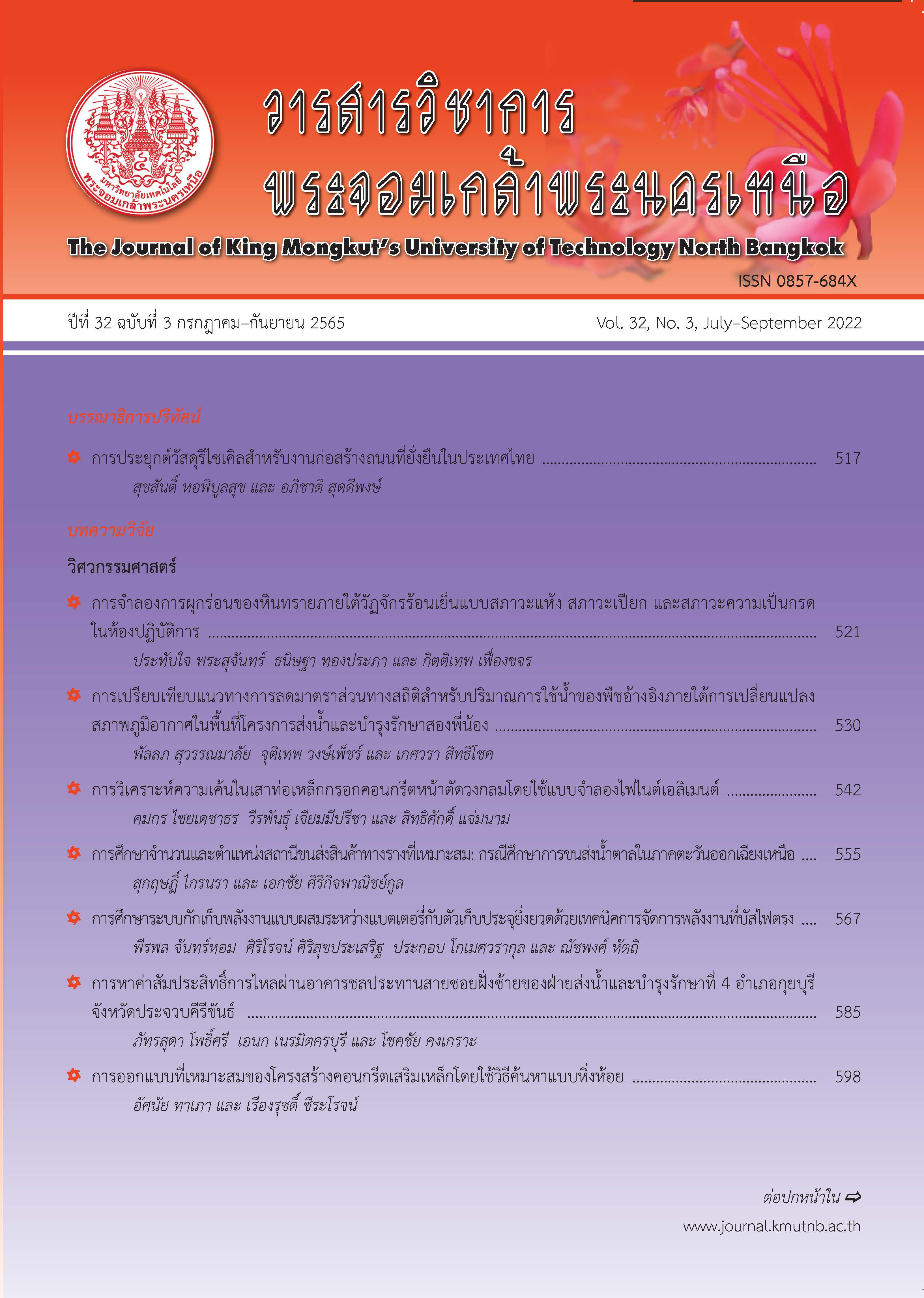สมบัติทางวิศวกรรมของแอสฟัลต์คอนกรีตผสมขยะพลาสติกพอลิเอทิลีน
Main Article Content
บทคัดย่อ
งานวิจัยนี้ศึกษาสมบัติทางวิศวกรรมของแอสฟัลต์คอนกรีตผสมขยะพลาสติกโพลิเอทธิลีน โดยใช้มวลรวมหินปูนจำนวน 1 แหล่ง อัตราส่วนผสมของหินร้อนเท่ากับ 44:22:18:16 โดยมวลของมวลรวม แอสฟัลต์ซีเมนต์ใช้เกรด 60-70 ปริมาณของขยะพลาสติกโพลิเอทธิลีน (PPW) เท่ากับร้อยละ 0 5 10 15 และ 20 โดยมวลของแอสฟัลต์ซีเมนต์ และลดปริมาณร้อยละการใช้แอสฟัลต์ซีเมนต์ลงตามปริมาณ PPW เท่ากับร้อยละ 5.00 4.75 4.50 4.25 และ 4.00 โดยมวลของมวลรวม ตามลำดับ เตรียมก้อนตัวอย่างโดยใช้วิธีมาร์แชลล์และเกณฑ์ชั้น Wearing Course ขนาด 12.5 มิลลิเมตร โดยทำการทดสอบสมบัติด้านความหนาแน่น เสถียรภาพ ค่าการไหล ช่องว่างอากาศ ช่องว่างระหว่างมวลรวม ช่องว่างที่ถูกแทนที่ด้วยแอสฟัลต์ ดัชนีความแข็งแรง ความต้านทานต่อแรงดึงทางอ้อม ค่าโมดูลัสคืนตัว ความต้านทานต่อการเปลี่ยนรูปอย่างถาวรแบบพลวัต และความล้าจากแรงดึงทางอ้อม ผลการทดสอบพบว่า เมื่อใช้ปริมาณ PPW เท่ากับร้อยละ 5 และปริมาณแอสฟัลต์ซีเมนต์เท่ากับร้อยละ 4.75 สมบัติดังกล่าวของแอสฟัลต์คอนกรีตผสมขยะพลาสติกโพลิเอทธิลีนอยู่ในเกณฑ์ที่ยอมรับได้ โดยที่ความต้านทานต่อแรงดึงทางอ้อมเท่ากับ 790 กิโลปาสคาล ค่าโมดูลัสคืนตัวเท่ากับ 1,012 เมกะปาสคาล ความต้านทานต่อการเปลี่ยนรูปอย่างถาวรแบบพลวัตอยู่ในช่วง 6,144 ถึง 16,606 ไมโครสเทรน และความล้าจากแรงดึงทางอ้อมเท่ากับ 2,131 รอบ
Article Details

อนุญาตภายใต้เงื่อนไข Creative Commons Attribution-NonCommercial-NoDerivatives 4.0 International License.
บทความที่ลงตีพิมพ์เป็นข้อคิดเห็นของผู้เขียนเท่านั้น
ผู้เขียนจะต้องเป็นผู้รับผิดชอบต่อผลทางกฎหมายใดๆ ที่อาจเกิดขึ้นจากบทความนั้น
เอกสารอ้างอิง
Plastic waste, global problems. (2018, December). Bangkokbiznews. [Online] (in Thai). Available: www.bangkokbiznews.com/news/detail/820466
The Secretariat of the Council of Ministers. (2019, November). The propulsion mechanism of abstinence using plastic bags. [Online]. Available: https://www2.soc.go.th/?page_id=3737&year=2019&month=11
A. Sultana SK and K. S. B. Prasad, “Utilization of waste plastic as a strength modifier in surface course of flexible and rigid pavements,” International Journal of Engineering Research and Applications, vol. 2, no. 4, pp. 1185–1191, 2012.
T. B. Moghaddam, M. R. Karim, and M. Solthani, “Utilization of waste plastic bottles in asphalt mixture,” Journal of Engineering Science and Technology, vol. 8, no. 3, pp. 264–271, 2013.
H. Jan, M. Y. Aman, S. Khan, and F. Karim, “Performance of hot asphalt mixtures containing plastic bottles as additive,” in Proceeding ISCEE, 2016, pp. 1–7.
A. O. Sojobi, S. E. Nwobodo, and O. J. Aladgegboye, “Recycling of polyethylene terephthalate (PET) plastic bottle wastes in bituminous asphaltic concrete,” Cogent Engineering, vol. 3, 2016.
W. Jongjit, O. Somchinuek, and C. Thipakornkiat, “Asphaltic concrete pavement using recycled material,” in Proceeding NCCE, 2017, pp. 1–9 (in Thai).
W. Lakas, W. Setthapun, and K. Lucksiri, “Process of asphaltic concrete pavement construction to reduce plastic waste problems in the community,” Academic Journal Uttaradit University, vol. 12, no. 1, pp. 41–53, 2017 (in Thai).
A. F. Ahmad, A. R. Razali, and I. S. Razelan, “Utilization of polyethylene terephthalate (PET) in asphalt pavement,” in Proceeding IOP, 2017, pp. 1–7.
S. S. Ali, N. Ijaz, N. Aman, and E. Noor, “Feasibility study of low density waste plastic in non-load bearing asphalt pavement in district faisalabed,” Earth Sciences Pakistan, vol. 1, no. 2, pp. 17–18.
A. Awad and F. A. Adday, “Utilization of waste plastics to enhance the performance of modified hot mix asphalt,” International Journal of GEOMATE, vol. 13, no. 40, pp. 132–139.
A. K. Mohamed, H. A. Mahdy, and K. A. Kandil, “The use of waste plastics in hot asphalt mixes in Egypt,” International Journal of Engineering and Advanced Technology, vol. 7, no. 3, 2018.
Guidelines for The Use of Waste Plastic in Hot Bituminous Mixes (Dry Process) in Wearing Courses, 1st ed., Indian Roads Congress, Delhi, 2014, pp. 1–13.
N. Nokkaew, Highway Materials Testing, Bangkok: Technology Promotion Association (Thailand–Japan) 2016 (in Thai).
Bureau of Materials, Research and Development, Standard Test Methods. Bangkok: Express Transportation Organization of Thailand, 2000, pp. 94–184.
Bureau of Materials, Research and Development, Standards for Highway Construction. Bangkok: The Agricultured Co-operative Federation of Thailand., Ltd., 1996, pp. 263–270.
Standard method of test for resistance of compacted asphalt mixture-included damage, Standard Specification Materials and Methods of Sampling and Testing AASHTO T 283, 2014.
Standard test method for effect of moisture on asphalt concrete paving mixtures, Annual Book of ASTM Standard ASTM D 4867, 2014.
Standard test method for Indirect tension test for resilient modulus for bituminous mixtures, Annual Book of ASTM Standard ASTM D 4123, 1995.
Standard test method for determing the resilient modulus of bituminous mixtures by direct tension, Standard Specification Materials and Methods of Sampling and Testing AASHTO TP31, 1996.
Method for determining resistance to permanent deformation of bituminous mixtures subject to unconfined dynamic loading, British Standards Institution, BS DD 226, 1996.
Bituminous mixtures test methods for hot mix asphalt-part 24: Resistance for fatigue, British Standards Institution, BS EN 12697-24, 2004.

